THE CLASSIC HORROR FILM
By Jeffrey-Baptiste Tarlofsky
By Jeffrey-Baptiste Tarlofsky
Lesson 20 consists of 9 video lectures and transcripts of those lectures, and 7 film excerpts. Start with the lecture, Part 1, and continue down the page in sequence until you reach the end of the lesson.
レッスン20は9本のビデオレクチャー(レクチャーのテキストがビデオレクチャーの下に記載されています)と7本の動画で構成されています。
このレッスンは、ページをスクロールダウンしながら最初から順番に動画を見たりテキストを読んでください。
Part 1 – The Wolf Man is an outlier in the Universal films of the 1940s because it is actually quite a good film, while the other films of the era are much less interesting. After the third Dracula sequel and the fourth Frankenstein sequel, Universal decided it wanted a sequel to The Wolf Man as well. They decided to try an experiment by combining the story of The Wolf Man with that of Frankenstein’s monster in Frankenstein Meets The Wolf Man (1943). What happens when these two monsters meet? Well, they do not sit down to discuss their problems over tea and cookies. They fight, of course. This film is followed by a sort of sequel in which the Wolf Man and Frankenstein’s monster are joined by Dracula in House of Frankenstein (1945) and finally in yet a final sequel they are joined by a new mad scientist and a new hunchback in House of Dracula (1945). These films all suffer badly from the problems sequels often suffer from — a lack of news ideas and audience fatigue. The monsters fight each other, but for no real reason. These films were known as “Monster Mashes” and they are the least interesting of the Universal films.
Then from 1948 until 1954, in a sort of last gasp, Universal would make comedy films starring comedians Abbot and Costello who would meet the various monsters from the classic period (including Bela Lugosi playing Dracula for only the second and final time). By this time the monsters were simply extras in the comedy films. They had fallen a long way from being the serious focus of their own films.

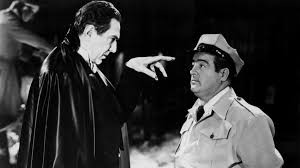
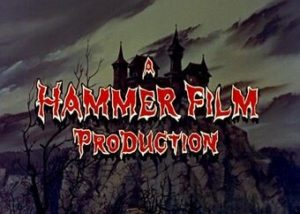
However, just as Universal was putting its horror films in the vault, another studio suddenly decided to reboot the Frankenstein story from the beginning. The small English studio Hammer was able to reboot both the Frankenstein and Dracula stories because these stories had fallen into the public domain* over time. How is it possible for Hammer to succeed where Universal was failing? Hammer had a whole new approach to horror. For one thing, their films would all be filmed in color and their favorite color was red. Hammer films would be far bloodier and more violent than any Universal had made. Moreover, Hammer understood, just as Shakespeare had understood, that what audiences are always willing to pay for is violence and sex, or sex and violence. That was the other thing Hammer added — sex. Hammer was far more willing to “sex up” their productions than Universal. Of course, it was easier for Hammer to do this because they were not subject to the rules of the P.C.A., which only had authority over movies produced in Hollywood, not England or other foreign countries. Some people find the Hammer reboots to be lots of fun, but for me, none of them are anywhere near as interesting as the Universal originals…well, except for one.
Recall that when Universal made its werewolf films, both The Werewolf of London and The Wolf Man, they deliberately avoided using the novel The Werewolf of Paris as the basis for the story because the author, Guy Endore, was associated with the Communist Party. Hammer didn’t care about Endore’s political associations and used his novel as the basis for their 1961 film, The Curse of the Werewolf. The result is the most interesting horror film Hammer made in its entire twenty-five-year history of making horror films. Let’s have a look at the opening scene.
*The term “public domain” refers to creative materials that are not protected by intellectual property laws such as copyright, trademark, or patent laws. The public owns these works, not an individual author or artist. Anyone can use a public domain work without obtaining permission, but no one can ever own it.
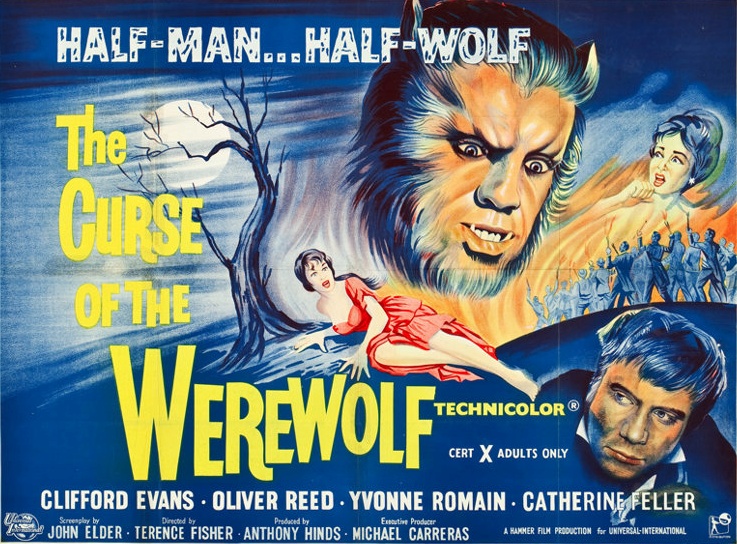
Directed by Terence Fisher
Produced by Anthony Hinds
Written by Anthony Hinds
Starring Clifford Evans, Oliver Reed, Yvonne Romain, Catherine Feller, Anthony Dawson, Michael Ripper
Music by Benjamin Frankel
Production company: Hammer Film Productions
Running time: 91 minutes
Part 2 – The novel on which this film was based, The Werewolf of Paris, takes place in France from the 1850s to the 1870s and is much concerned with the history of France at this time. The film, however, is set in Spain much earlier and does not have any specific political references to events or people. But the film does retain Endore’s characteristic concern with the working class. England in the 1950s and 1960s was a very different country from the United States. Censorship in the U.S. in the 1950s turned from being mainly concerned with sex to being mainly concerned with politics. Any hint of sympathy for communism (or even socialism) was strictly censored. But following World War Two the governments of the U.K. switched back and forth between the Conservative Party and the (socialist) Labour Party. There was far more sympathy for and depictions of the working class in British films than American ones. The opening scene of The Curse of the Werewolf has a peasant (i.e., a worker) explaining that he and the others in the tavern have nothing to spare for the beggar because the local nobleman, the Marquis, has taken all they have to pay for his fancy wedding and the feast taking place at the castle. What a feast it is!
Part 3 – I happened to be watching the news while having lunch just before sitting down to write this and according to NBC news there are 54,000,000 Americans who are food insecure as of November 2020. No doubt many of them are people who lost jobs due to the COVUD pandemic, but that is still a staggering number of hungry people, especially in a country that claims to be the “richest” in the world. Rich it may be, but the real question is: who has the money when 54,000,000 of my countrymen are hungry?
Obviously, this is a point The Curse of the Werewolf is making as we see the feast that has been prepared for the Marquis’s wedding. Chef after chef brings in his best dishes accompanied by music and the applause and cheers of the guests. One of the dishes is a roast goose carefully made to appear as if it were alive and in flight. It is quite an achievement and the guests raise a cheer to the smiling chef — but wait — the bride looks uncomfortable.
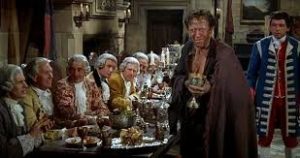 Like a lot of people who eat meat, she doesn’t really want to think about or have to see what animal her dinner might have come from. Sensing her distress, the Marquis silences the hall and demands to know why the chef has made goose when his wife does not like goose. The chef honestly says he didn’t know and now we see the game the Marquis is playing as he asks, “Why didn’t you know?” Apparently, the chef knows the temper of the Marquis well enough to immediately beg for mercy and perhaps he is lucky that the Marquis only dumps his carefully prepared goose on the floor and then commands him to “pick it up”. For good measure, the Marquis shoves him so he falls into the mess on the floor. It is, of course, a wonderful joke for him to laugh at and, on cue, all the guests join in laughing at the humiliated man. The chef, of course, considers himself very lucky that nothing worse happened to him.
Like a lot of people who eat meat, she doesn’t really want to think about or have to see what animal her dinner might have come from. Sensing her distress, the Marquis silences the hall and demands to know why the chef has made goose when his wife does not like goose. The chef honestly says he didn’t know and now we see the game the Marquis is playing as he asks, “Why didn’t you know?” Apparently, the chef knows the temper of the Marquis well enough to immediately beg for mercy and perhaps he is lucky that the Marquis only dumps his carefully prepared goose on the floor and then commands him to “pick it up”. For good measure, the Marquis shoves him so he falls into the mess on the floor. It is, of course, a wonderful joke for him to laugh at and, on cue, all the guests join in laughing at the humiliated man. The chef, of course, considers himself very lucky that nothing worse happened to him.
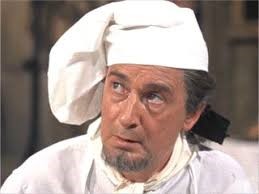
 This is how the nobility could treat the people under their rule. They could humiliate and abuse them as they pleased. As for the goose? Well, let’s see what happens next.
This is how the nobility could treat the people under their rule. They could humiliate and abuse them as they pleased. As for the goose? Well, let’s see what happens next.
The beggar is, indeed, a man. He is a poor and hungry man, but a man nonetheless, and so he is free to choose between good and evil….if given that choice. At this point, I should explain that while we never hear his name in the film, the Marquis’s name is the Marquis Di Sinistro in the credits of the film. The Latin adjective sinister/sinistra/sinistrum originally meant “left” but took on meanings of “evil” or “unlucky” in the Classical Latin era, and this double meaning survives in European derivatives of Latin, and in the English word “sinister”. So, the translation of his name into English would be “Lord Evil” or “the Lord of Evil”. This is very clearly a reference to Satan. In other words, the Marquis is a symbol of Satan.
If you recall, it was Satan (disguised as a snake) who tricked Eve into eating the fruit of knowledge so that she and Adam would have the knowledge of good and evil. Recall also that because they disobeyed God, Adam and Eve are forced to leave the Garden of Eden and become mortal (they will die someday). But only their bodies will die. Their human souls will continue. Depending on whether they have been good or evil their souls will either go to heaven or to hell. It is their choice whether to be good or evil because they have the knowledge of good and evil and are free to choose between the two. So, why would anyone choose evil when it means going to hell?
Life outside the Garden of Eden is not easy for humans. They must work for their bread and sometimes they go hungry. Perhaps it would be easier to just steal the bread? Perhaps it would be easier still to just rob people of their money so we can buy bread or anything else we want or need? Maybe it is even easier to kill those we rob in case they can identify us to the police? And so it goes. We find ourselves doing evil because it is easier than being good.
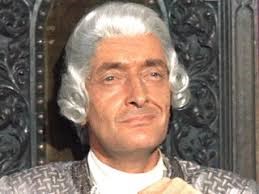
 Now, let’s talk about what the beggar was offered for his soul: ten pesetas. The peseta was a silver coin used in Spain up until recent times. What is the significance of the coins being made of silver? Silver is, of course, the only thing that can kill a werewolf: either a silver bullet, silver knife, or silver walking stick (as we saw in the Wolfman). But why silver and not gold? For the answer to this question, we must go back almost two thousand years to the night Jesus Christ held his last supper with his disciples. At the last supper, Jesus tells his disciples that it is the last time they will see him alive because that night one of them will betray him to the Romans who are looking for him. They all swear that they are loyal to him, but that very night as they sleep one of them, Judas Iscariot, sneaks out and finds the Roman soldiers and brings them to the place where Jesus and the others are hiding. The Romans do not know which one is Jesus so Judas Iscariot steps up to Jesus and kisses him (this is what is called “the kiss of death”). Jesus is arrested and you probably know the rest of the story. He is given a trial and convicted of crimes and sentenced to death by crucifixion. Why did Judas Iscariot betray Jesus? He was paid thirty pieces of silver by the Romans as a reward for his betrayal. Judas was said to have “sold his soul” (done a terrible, evil thing) for silver. Of course, the beggar has reenacted the “selling of his soul for silver” which Judas committed. From your homework reading, you recall that Christians believed that werewolves were men (and sometimes women) who had sold their souls to Satan in much the same way that they believed witches had done.
Now, let’s talk about what the beggar was offered for his soul: ten pesetas. The peseta was a silver coin used in Spain up until recent times. What is the significance of the coins being made of silver? Silver is, of course, the only thing that can kill a werewolf: either a silver bullet, silver knife, or silver walking stick (as we saw in the Wolfman). But why silver and not gold? For the answer to this question, we must go back almost two thousand years to the night Jesus Christ held his last supper with his disciples. At the last supper, Jesus tells his disciples that it is the last time they will see him alive because that night one of them will betray him to the Romans who are looking for him. They all swear that they are loyal to him, but that very night as they sleep one of them, Judas Iscariot, sneaks out and finds the Roman soldiers and brings them to the place where Jesus and the others are hiding. The Romans do not know which one is Jesus so Judas Iscariot steps up to Jesus and kisses him (this is what is called “the kiss of death”). Jesus is arrested and you probably know the rest of the story. He is given a trial and convicted of crimes and sentenced to death by crucifixion. Why did Judas Iscariot betray Jesus? He was paid thirty pieces of silver by the Romans as a reward for his betrayal. Judas was said to have “sold his soul” (done a terrible, evil thing) for silver. Of course, the beggar has reenacted the “selling of his soul for silver” which Judas committed. From your homework reading, you recall that Christians believed that werewolves were men (and sometimes women) who had sold their souls to Satan in much the same way that they believed witches had done.
Once the beggar makes the terrible mistake of accepting the Marquis’ offer, he is given wine to make him drunk and instructed to sing or dance. After he falls to the ground exhausted the Marquis tells him he is a “good dog! Come and get your bone” whereupon the beggar pretends to be a dog begging for a bone.
As the Marquis and his new bride leave the hall, the beggar makes a lewd remark, “Have a good night”, which causes the Marquis to have him “looked after”. We see what that means in the next excerpt.
Part 6 – Being imprisoned in the castle dungeon begins a years-long process of “dehumanization” of the beggar who stops speaking and gradually grows dirtier and more animal-like as the years go by. He also starts to become hairier as if living like an animal is making him hairy like an animal. Like Judas who sold himself for silver coins and betrayed his friend Jesus, the beggar has sold himself and later betrays his friend, the servant girl who cannot speak, by raping her. Of course, it is again the marquis who is the ultimate source of this evil.


The Marquis has sexually harassed (that is a terrible understatement) the servant girl and when she bites his hand to escape, he has his guards take her to the dungeon knowing the beggar will probably rape her. He reasons that once she has been raped by the beggar she will have “learned her lesson” and allow him to rape her.
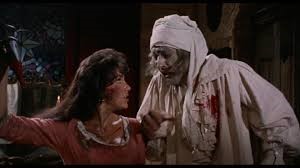
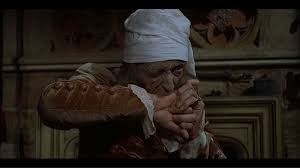

She obviously had something else in mind.
Part 7 – The Curse of the Werewolf is a reboot of the Wolfman (1941). We know that the word “werewolf” is identical to “wolfman” since the word “were” is simply an older English form of the word “man”. But the film is not titled simply The Werewolf, it is titled The Curse of The Werewolf. What is the significance of the word “curse” in the title? Used as a verb, “to curse” means to utter a blasphemy or to swear, or to use magic to bring misfortune to others. Its noun form refers to the result of such magic. If someone is “cursed” they have an evil spell upon them. In some cultures, it is believed that curses are sometimes passed from one generation to the next in a family. This makes perfect sense when you consider that most physical and mental abnormalities (for example, dwarfism) are genetic conditions that actually are passed from one generation to the next. Before people understood genetics they would have believed such conditions were “family curses”. You also read about the condition known as “hypertrichosis” in which people, especially men, grow excessive amounts of hair all over their bodies and faces. This was also a genetic condition. In the next excerpt, we will see what has been passed on to the next generation.
Part 8 – The little boy, Leon, is our werewolf. Since Leon has not been bitten by a werewolf or himself encountered anyone who has put him under an evil spell or curse, it is reasonable to assume that his curse is inherited either from his father or his mother or both. This also makes sense in terms of our experience watching the film. After all, why would the story spend so much time with Leon’s parents if they were not relevant to the story of him being a werewolf?
Now our task is to consider which parent (or both) is the source of the werewolf curse. Let us start with his mother since it is certain that she is the mute servant girl. We recall that Christians also believed that God punished the wicked with afflictions. Could the servant girl have been born mute because she was evil and actually be under a curse from heaven? That was an old superstition, but thankfully most movies never followed this superstition.
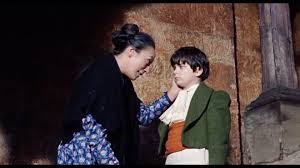
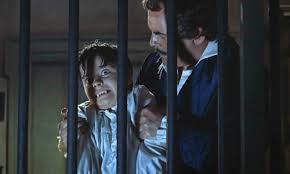
Of course, the servant girl did kill the Marques (in one of those bloody scenes Hammer studios was so fond of showing in detail). Yet, from our experiences judging the guilt or innocence of the Frankenstein Monster we have certainly learned that killing in self-defense is not the same as murder. Since the servant girl was clearly defending herself against rape (actually a second rape), she cannot be guilty of murder and so it appears she is not the source of the curse.
Moreover, since the servant girl killed the Marques before he could rape her, the only other possible man who could be Leon’s father is the beggar. Rather obviously, the curse comes from the beggar having sold his soul to the Satanic figure of the Marquis for ten pieces of silver that leads to his humiliation, his imprisonment, his slow dehumanization, and eventually to his raping the servant girl. But perhaps the village priest can do a better job of explaining all this.
Part 9 – We are right back to a very old idea in the horror film, one that Lon Chaney explored in the Phantom of the Opera. It is the idea that love can overcome evil. Much later, in Bram Stoker’s Dracula, Francis Ford Coppola will have Dracula saved at the very end of the film by the transformative power of love. In the next lesson we will see what happens to Leon when he grows into a handsome young man, but one who has a certain…affliction. Will love be enough to save him?
